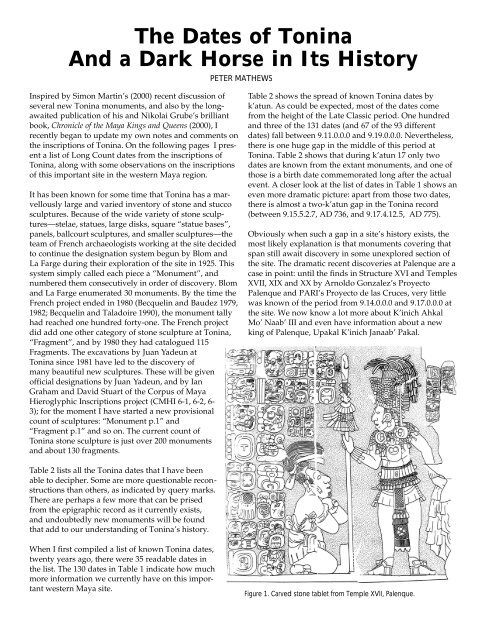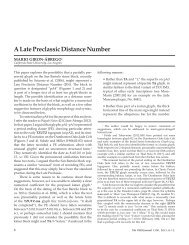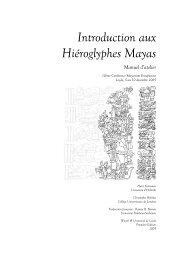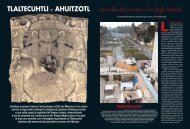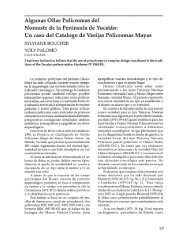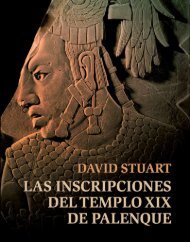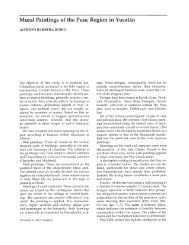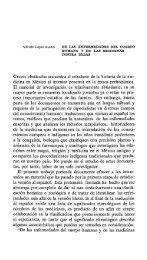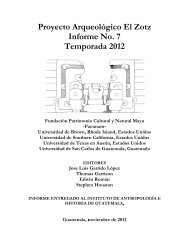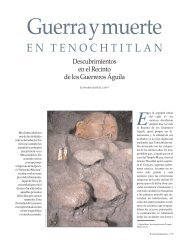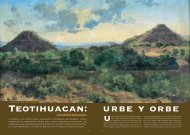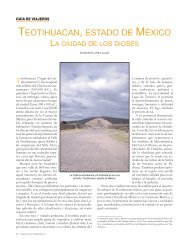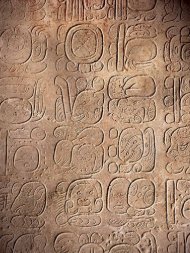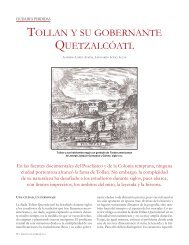The Dates of Tonina And a Dark Horse in Its History - Mesoweb
The Dates of Tonina And a Dark Horse in Its History - Mesoweb
The Dates of Tonina And a Dark Horse in Its History - Mesoweb
You also want an ePaper? Increase the reach of your titles
YUMPU automatically turns print PDFs into web optimized ePapers that Google loves.
<strong>The</strong> <strong>Dates</strong> <strong>of</strong> <strong>Ton<strong>in</strong>a</strong><br />
<strong>And</strong> a <strong>Dark</strong> <strong>Horse</strong> <strong>in</strong> <strong>Its</strong> <strong>History</strong><br />
Inspired by Simon Mart<strong>in</strong>’s (2000) recent discussion <strong>of</strong><br />
several new <strong>Ton<strong>in</strong>a</strong> monuments, and also by the longawaited<br />
publication <strong>of</strong> his and Nikolai Grube’s brilliant<br />
book, Chronicle <strong>of</strong> the Maya K<strong>in</strong>gs and Queens (2000), I<br />
recently began to update my own notes and comments on<br />
the <strong>in</strong>scriptions <strong>of</strong> <strong>Ton<strong>in</strong>a</strong>. On the follow<strong>in</strong>g pages I present<br />
a list <strong>of</strong> Long Count dates from the <strong>in</strong>scriptions <strong>of</strong><br />
<strong>Ton<strong>in</strong>a</strong>, along with some observations on the <strong>in</strong>scriptions<br />
<strong>of</strong> this important site <strong>in</strong> the western Maya region.<br />
It has been known for some time that <strong>Ton<strong>in</strong>a</strong> has a marvellously<br />
large and varied <strong>in</strong>ventory <strong>of</strong> stone and stucco<br />
sculptures. Because <strong>of</strong> the wide variety <strong>of</strong> stone sculptures—stelae,<br />
statues, large disks, square “statue bases”,<br />
panels, ballcourt sculptures, and smaller sculptures—the<br />
team <strong>of</strong> French archaeologists work<strong>in</strong>g at the site decided<br />
to cont<strong>in</strong>ue the designation system begun by Blom and<br />
La Farge dur<strong>in</strong>g their exploration <strong>of</strong> the site <strong>in</strong> 1925. This<br />
system simply called each piece a “Monument”, and<br />
numbered them consecutively <strong>in</strong> order <strong>of</strong> discovery. Blom<br />
and La Farge enumerated 30 monuments. By the time the<br />
French project ended <strong>in</strong> 1980 (Becquel<strong>in</strong> and Baudez 1979,<br />
1982; Becquel<strong>in</strong> and Taladoire 1990), the monument tally<br />
had reached one hundred forty-one. <strong>The</strong> French project<br />
did add one other category <strong>of</strong> stone sculpture at <strong>Ton<strong>in</strong>a</strong>,<br />
“Fragment”, and by 1980 they had catalogued 115<br />
Fragments. <strong>The</strong> excavations by Juan Yadeun at<br />
<strong>Ton<strong>in</strong>a</strong> s<strong>in</strong>ce 1981 have led to the discovery <strong>of</strong><br />
many beautiful new sculptures. <strong>The</strong>se will be given<br />
<strong>of</strong>ficial designations by Juan Yadeun, and by Ian<br />
Graham and David Stuart <strong>of</strong> the Corpus <strong>of</strong> Maya<br />
Hieroglyphic Inscriptions project (CMHI 6-1, 6-2, 6-<br />
3); for the moment I have started a new provisional<br />
count <strong>of</strong> sculptures: “Monument p.1” and<br />
“Fragment p.1” and so on. <strong>The</strong> current count <strong>of</strong><br />
<strong>Ton<strong>in</strong>a</strong> stone sculpture is just over 200 monuments<br />
and about 130 fragments.<br />
Table 2 lists all the <strong>Ton<strong>in</strong>a</strong> dates that I have been<br />
able to decipher. Some are more questionable reconstructions<br />
than others, as <strong>in</strong>dicated by query marks.<br />
<strong>The</strong>re are perhaps a few more that can be prised<br />
from the epigraphic record as it currently exists,<br />
and undoubtedly new monuments will be found<br />
that add to our understand<strong>in</strong>g <strong>of</strong> <strong>Ton<strong>in</strong>a</strong>’s history.<br />
When I first compiled a list <strong>of</strong> known <strong>Ton<strong>in</strong>a</strong> dates,<br />
twenty years ago, there were 35 readable dates <strong>in</strong><br />
the list. <strong>The</strong> 130 dates <strong>in</strong> Table 1 <strong>in</strong>dicate how much<br />
more <strong>in</strong>formation we currently have on this important<br />
western Maya site.<br />
PETER MATHEWS<br />
Table 2 shows the spread <strong>of</strong> known <strong>Ton<strong>in</strong>a</strong> dates by<br />
k’atun. As could be expected, most <strong>of</strong> the dates come<br />
from the height <strong>of</strong> the Late Classic period. One hundred<br />
and three <strong>of</strong> the 131 dates (and 67 <strong>of</strong> the 93 different<br />
dates) fall between 9.11.0.0.0 and 9.19.0.0.0. Nevertheless,<br />
there is one huge gap <strong>in</strong> the middle <strong>of</strong> this period at<br />
<strong>Ton<strong>in</strong>a</strong>. Table 2 shows that dur<strong>in</strong>g k’atun 17 only two<br />
dates are known from the extant monuments, and one <strong>of</strong><br />
those is a birth date commemorated long after the actual<br />
event. A closer look at the list <strong>of</strong> dates <strong>in</strong> Table 1 shows an<br />
even more dramatic picture: apart from those two dates,<br />
there is almost a two-k’atun gap <strong>in</strong> the <strong>Ton<strong>in</strong>a</strong> record<br />
(between 9.15.5.2.7, AD 736, and 9.17.4.12.5, AD 775).<br />
Obviously when such a gap <strong>in</strong> a site’s history exists, the<br />
most likely explanation is that monuments cover<strong>in</strong>g that<br />
span still await discovery <strong>in</strong> some unexplored section <strong>of</strong><br />
the site. <strong>The</strong> dramatic recent discoveries at Palenque are a<br />
case <strong>in</strong> po<strong>in</strong>t: until the f<strong>in</strong>ds <strong>in</strong> Structure XVI and Temples<br />
XVII, XIX and XX by Arnoldo Gonzalez’s Proyecto<br />
Palenque and PARI’s Proyecto de las Cruces, very little<br />
was known <strong>of</strong> the period from 9.14.0.0.0 and 9.17.0.0.0 at<br />
the site. We now know a lot more about K’<strong>in</strong>ich Ahkal<br />
Mo’ Naab’ III and even have <strong>in</strong>formation about a new<br />
k<strong>in</strong>g <strong>of</strong> Palenque, Upakal K’<strong>in</strong>ich Janaab’ Pakal.<br />
Figure 1. Carved stone tablet from Temple XVII, Palenque.
Nevertheless, at <strong>Ton<strong>in</strong>a</strong> most <strong>of</strong> the monuments have<br />
been scattered around the site after their <strong>in</strong>itial placement,<br />
and although much excavation still needs to be<br />
done at <strong>Ton<strong>in</strong>a</strong>, there are few major areas <strong>of</strong> the site<br />
await<strong>in</strong>g <strong>in</strong>vestigation. To be sure, there are other gaps <strong>in</strong><br />
the <strong>Ton<strong>in</strong>a</strong> sequence, both dur<strong>in</strong>g the Early Classic period<br />
and towards the end <strong>of</strong> the site’s history. However the<br />
Early Classic gap can be expla<strong>in</strong>ed by the fact that Early<br />
Classic material at <strong>Ton<strong>in</strong>a</strong> is only just now be<strong>in</strong>g excavated,<br />
deep below the massive Late Classic construction that<br />
covers most <strong>of</strong> the Acropolis at <strong>Ton<strong>in</strong>a</strong>. Surely new monuments<br />
from <strong>Ton<strong>in</strong>a</strong>’s early history still await discovery.<br />
<strong>The</strong> much later gap <strong>in</strong> <strong>Ton<strong>in</strong>a</strong>’s sequence is at a time<br />
when far fewer monuments were be<strong>in</strong>g produced, and<br />
also perhaps we could expect a greater degree <strong>of</strong> destruction,<br />
s<strong>in</strong>ce those monuments would more likely have<br />
been visible to the Postclassic occupiers <strong>of</strong> the site. But<br />
the gap between AD 736 and 775 is less easy to expla<strong>in</strong>: it<br />
is smack <strong>in</strong> the middle <strong>of</strong> the greatest period <strong>in</strong> <strong>Ton<strong>in</strong>a</strong>’s<br />
history. If <strong>Ton<strong>in</strong>a</strong>’s fortunes rema<strong>in</strong>ed strong dur<strong>in</strong>g this<br />
“gap,” surely we would have more monuments to document<br />
the period.<br />
<strong>The</strong>refore, a second possible explanation for the long gap<br />
<strong>in</strong> <strong>Ton<strong>in</strong>a</strong>’s monument sequence comes to m<strong>in</strong>d: perhaps<br />
<strong>Ton<strong>in</strong>a</strong> was <strong>in</strong> a temporary decl<strong>in</strong>e at this time. Certa<strong>in</strong>ly<br />
we know much about <strong>Ton<strong>in</strong>a</strong>’s stormy relationship with<br />
its neighbours dur<strong>in</strong>g earlier times.<br />
<strong>The</strong> first known reference to <strong>Ton<strong>in</strong>a</strong> away from the site is<br />
on Ch<strong>in</strong>ikiha Throne 1, which records that on 9.7.0.1.0<br />
(AD 573) a person from <strong>Ton<strong>in</strong>a</strong> was captured, presumably<br />
by the lord <strong>of</strong> Ch<strong>in</strong>ikiha (a site north <strong>of</strong> <strong>Ton<strong>in</strong>a</strong> near the<br />
Usumac<strong>in</strong>ta river). Most <strong>of</strong> the subsequent war references<br />
<strong>in</strong>volv<strong>in</strong>g <strong>Ton<strong>in</strong>a</strong> are found <strong>in</strong> the numerous <strong>in</strong>scriptions<br />
<strong>of</strong> <strong>Ton<strong>in</strong>a</strong> itself, and battle references and scenes span<br />
most <strong>of</strong> the known history <strong>of</strong> <strong>Ton<strong>in</strong>a</strong>. Many <strong>of</strong> the most<br />
famous battles were dur<strong>in</strong>g the reign <strong>of</strong> the k<strong>in</strong>g K’<strong>in</strong>ich<br />
B’aaknal-Chaak, who was born <strong>in</strong> AD 652, and enthroned<br />
at <strong>Ton<strong>in</strong>a</strong> <strong>in</strong> 688 (9.12.16.3.12, recorded on no fewer than<br />
six monuments). We do not have B’aaknal-Chaak’s death<br />
date, but it is likely that he lived at least until 704, and<br />
probably until 708 or 709.<br />
Perhaps the most famous work undertaken by B’aaknal-<br />
Chaak was the huge sunken Ballcourt 1, which was dedicated<br />
at the height <strong>of</strong> his power on 9.13.7.14.7 (AD 699).<br />
This Ballcourt had an impressive sculptural program,<br />
<strong>in</strong>clud<strong>in</strong>g tenoned captive sculptures carved <strong>in</strong> the round,<br />
kneel<strong>in</strong>g over large rectangular shields that conta<strong>in</strong>ed<br />
their names. Most <strong>of</strong> these panels have survived, and several<br />
<strong>of</strong> the names survive.<br />
For example, one <strong>of</strong> the shields—Monument 72—names a<br />
certa<strong>in</strong> Chan-Maas as one <strong>of</strong> the captives. Chan-Maas is<br />
portrayed on Monument 84, which also records his cap-<br />
ture date as 8 K’an. This date is almost certa<strong>in</strong>ly 9.13.1.0.4,<br />
recorded on Monuments 151 and p.35. Monument 65,<br />
another <strong>of</strong> the shields, names the captive Sak-B’alam, and<br />
he is called an “ajaw <strong>of</strong> Aj Pitz, Palenque Ajaw”. This<br />
means that Sak B’alam was a noble from the neighbour<strong>in</strong>g<br />
k<strong>in</strong>gdom <strong>of</strong> Palenque, and that <strong>Ton<strong>in</strong>a</strong> warred aga<strong>in</strong>st<br />
Palenque at this time. Sak-B’alam is portrayed on<br />
Fragment 43, which names his capture date as 8<br />
Kumk’u—unfortunately the tzolk’<strong>in</strong> position is broken<br />
<strong>of</strong>f. Almost certa<strong>in</strong>ly, Sak-B’alam was captured between<br />
the accession <strong>of</strong> B’aaknal-Chaak <strong>in</strong> 688 and the dedication<br />
<strong>of</strong> Ballcourt 1 <strong>in</strong> 699.<br />
Three other captures made by K’<strong>in</strong>ich B’aaknal-Chaak<br />
dur<strong>in</strong>g this period were on 9.12.19.16.5 (Lex<strong>in</strong>gton Panel),<br />
9.13.0.10.3 (M.145, M.p49), and 9.13.4.13.10 (M.141), and I<br />
th<strong>in</strong>k it is likely that these dates represent the capture<br />
dates <strong>of</strong> three <strong>of</strong> the other Ballcourt captives. It is tempt<strong>in</strong>g<br />
to th<strong>in</strong>k that Monument 140 may conta<strong>in</strong> the sixth<br />
capture date <strong>of</strong> the set: on it is recorded the date<br />
9.13.4.6.7, but unfortunately the event is miss<strong>in</strong>g, so we<br />
can’t be sure.<br />
<strong>The</strong> dedication <strong>of</strong> Ballcourt 1 and the six capture events<br />
that preceded it represent highlights <strong>in</strong> the history <strong>of</strong><br />
<strong>Ton<strong>in</strong>a</strong>. B’aaknal-Chaak’s successor, Ruler 4, made one<br />
even greater conquest, however. Monument 122 portrays<br />
the Palenque k<strong>in</strong>g K’an-Joy-Chitam, second son <strong>of</strong><br />
Janaab’-Pakal the Great, dressed as a royal sacrificial captive.<br />
He was captured <strong>in</strong> AD 711.<br />
It is <strong>in</strong> the context <strong>of</strong> these battles that we can turn to one<br />
<strong>of</strong> the more enigmatic war references <strong>in</strong>volv<strong>in</strong>g <strong>Ton<strong>in</strong>a</strong>.<br />
This is a record on the Sanctuary Tablet <strong>of</strong> Temple XVII at<br />
Palenque (Figure 1).<br />
This tablet portrays a Palenque k<strong>in</strong>g dressed <strong>in</strong> military<br />
costume and stand<strong>in</strong>g over a kneel<strong>in</strong>g captive. <strong>The</strong> ma<strong>in</strong><br />
text on the left side <strong>of</strong> the tablet talks about the found<strong>in</strong>g<br />
<strong>of</strong> Lakamha, the ceremonial center <strong>of</strong> Palenque known so<br />
well to tourists today. <strong>The</strong> date was AD 490, and the k<strong>in</strong>g<br />
was B’utz’aj-Sak-Chiik. <strong>The</strong> text then goes on to talk<br />
about the accession <strong>of</strong> the next k<strong>in</strong>g <strong>of</strong> Palenque, Ahkal<br />
Mo’-Naab’ I, on AD 501.<br />
<strong>The</strong>re are also two small glyphic captions on the Tablet <strong>of</strong><br />
Temple XVII, and because both are militaristic <strong>in</strong> nature,<br />
it is likely that the scene on the tablet refers to one or<br />
other <strong>of</strong> them. <strong>The</strong> first caption talks about a capture on a<br />
date that has generally been <strong>in</strong>terpreted as 9.13.2.15.15<br />
(AD 695).<br />
<strong>The</strong> second caption (Figure 2) is not complete, but the<br />
event is “entered, the center <strong>of</strong> the Reed-Throne Spirit<br />
Companion ... Lord”. This is a reference to <strong>Ton<strong>in</strong>a</strong>, and it<br />
<strong>in</strong>dicates that a Palenque attack reached the center <strong>of</strong> that<br />
2
city. <strong>The</strong> actor <strong>of</strong> the event<br />
(and unfortunately the text<br />
is partially broken here) is<br />
called the “Bone-Spirit<br />
Companion”. <strong>The</strong> problem<br />
with this passage has<br />
always been its date. <strong>The</strong><br />
Calendar Round date is<br />
clear: 10 Chuwen 4 Sak.<br />
But where to place it <strong>in</strong> the<br />
Long Count? When we<br />
first saw this tablet, L<strong>in</strong>da<br />
Schele and I could not<br />
make up our m<strong>in</strong>ds as to<br />
whether the Long Count<br />
position was 9.12.15.7.11<br />
(AD 687) or 9.15.8.2.11 (AD<br />
739).<br />
<strong>The</strong> conventional view<br />
now is that the earlier <strong>of</strong><br />
these two dates is the correct<br />
one. This view has<br />
much to recommend it.<br />
First, “Bone-Spirit<br />
Companion” is a wellknown<br />
epithet <strong>of</strong> Kan-<br />
B’alam, the k<strong>in</strong>g <strong>of</strong><br />
Palenque from AD 684 to<br />
702. Second, the date<br />
9.12.15.7.11 is less than a<br />
year before the accession<br />
<strong>of</strong> B’aaknal-Chaak <strong>of</strong><br />
<strong>Ton<strong>in</strong>a</strong>. Areasonable <strong>in</strong>ference<br />
could be that his<br />
predecessor, Ruler 2, either<br />
died <strong>in</strong> the battle or was<br />
captured and sacrificed by<br />
Kan-B’alam. Further, it<br />
would help expla<strong>in</strong><br />
B’aaknal-Chaak’s subsequent<br />
attacks on Palenque,<br />
for <strong>in</strong> part they would be<br />
to avenge the death <strong>of</strong> his<br />
predecessor.<br />
However, there is an alternative,<br />
and I would now<br />
like to revisit it, especially<br />
<strong>in</strong> view <strong>of</strong> the 40 year gap<br />
<strong>in</strong> the history <strong>of</strong> <strong>Ton<strong>in</strong>a</strong><br />
discussed above. <strong>The</strong> second<br />
alternative for this<br />
date is very near the<br />
beg<strong>in</strong>n<strong>in</strong>g <strong>of</strong> this gap. It is<br />
3<br />
possible that the Tablet <strong>of</strong><br />
Temple XVII represents<br />
Palenque’s revenge on<br />
<strong>Ton<strong>in</strong>a</strong>, for the capture and<br />
death, 28 years earlier, <strong>of</strong><br />
K’an-Joy-Chitam.<br />
So, while the smart money<br />
is perhaps still on the<br />
Temple XVII date at<br />
Palenque be<strong>in</strong>g from the<br />
reign <strong>of</strong> Kan-Balam, a date<br />
52 years later—one that<br />
ushers <strong>in</strong> a 40-year decl<strong>in</strong>e<br />
at <strong>Ton<strong>in</strong>a</strong>—is a dark horse<br />
worthy <strong>of</strong> some consideration.<br />
References<br />
Becquel<strong>in</strong>, Pierre, and Claude<br />
F. Baudez<br />
1979-1982 <strong>Ton<strong>in</strong>a</strong>, Une Cité<br />
Maya du Chiapas. 3 volumes.<br />
Mission Archéologique et<br />
Ethnologique Française au<br />
Mexique. Collection Études<br />
Mésoamérica<strong>in</strong>es, 6-1,2,3.<br />
Paris.<br />
Becquel<strong>in</strong>, Pierre, and Eric<br />
Taladoire<br />
1979-1982 <strong>Ton<strong>in</strong>a</strong>, Une Cité<br />
Maya du Chiapas. Tome IV.<br />
Mission Archéologique et<br />
Ethnologique Française au<br />
Mexique. Collection Études<br />
Mésoamérica<strong>in</strong>es, 6-4. Paris.<br />
Corpus <strong>of</strong> Maya Hieroglyphic<br />
Inscriptions<br />
1983-1999 Volume 6, Parts 1, 2,<br />
3. <strong>Ton<strong>in</strong>a</strong>. (by Peter Mathews<br />
and Ian Graham). Cambridge,<br />
Massachusetts: Peabody<br />
Museum <strong>of</strong> Archaeology and<br />
Ethnology, Harvard<br />
University.<br />
Mart<strong>in</strong>, Simon<br />
2000 New Monuments <strong>in</strong> the<br />
<strong>Ton<strong>in</strong>a</strong> Museum. Typescript.<br />
Mart<strong>in</strong>, Simon, and Nikolai<br />
Grube<br />
2000 Chronicle <strong>of</strong> the Maya<br />
K<strong>in</strong>gs and Queens. London:<br />
Thames and Hudson.<br />
Figure 2. Hieroglyphic caption from carved stone panel <strong>of</strong> Temple<br />
XVII, Palenque.<br />
Table 1. <strong>Ton<strong>in</strong>a</strong> dates, arranged by k’atun.<br />
No. <strong>of</strong><br />
K’atun No. <strong>of</strong> <strong>Dates</strong> Different <strong>Dates</strong><br />
9. 3.0.0.1 - 9. 4.0.0.0 10 10<br />
9. 4.0.0.1 - 9. 5.0.0.0 - -<br />
9. 5.0.0.1 - 9. 6.0.0.0 - -<br />
9. 6.0.0.1 - 9. 7.0.0.0 1 1<br />
9. 7.0.0.1 - 9. 8.0.0.0 4 4<br />
9. 8.0.0.1 - 9. 9.0.0.0 3 3<br />
9. 9.0.0.1 - 9.10.0.0.0 3 2<br />
9.10.0.0.1 - 9.11.0.0.0 2 2<br />
9.11.0.0.1 - 9.12.0.0.0 6 4<br />
9.12.0.0.1 - 9.13.0.0.0 14 7<br />
9.13.0.0.1 - 9.14.0.0.0 27 17<br />
9.14.0.0.1 - 9.15.0.0.0 20 14<br />
9.15.0.0.1 - 9.16.0.0.0 10 6<br />
9.16.0.0.1 - 9.17.0.0.0 2 2<br />
9.17.0.0.1 - 9.18.0.0.0 10 6<br />
9.18.0.0.1 - 9.19.0.0.0 13 10<br />
9.19.0.0.1 - 10. 0.0.0.0 - -<br />
10. 0.0.0.1 - 10. 1.0.0.0 1 1<br />
10. 1.0.0.1 - 10. 2.0.0.0 - -<br />
10. 2.0.0.1 - 10. 3.0.0.0 - -<br />
10. 3.0.0.1 - 10. 4.0.0.0 3 3
Table 2. A list <strong>of</strong> <strong>Ton<strong>in</strong>a</strong> <strong>Dates</strong>.<br />
Long Count Calendar Round AD Monument(s) Event Protagonist<br />
(13.0.0.0.0) 4 Ajaw 8 Kumk’u (3114 BC) M.p 3 Creation —<br />
(9.3.6.1.15) 13 Men 3 Pax 501 M.p43 ?? Ruler X<br />
(9.3.10.14.0) *8 Ajaw (3 Ch’en) ?? 505 M.p43 death ??<br />
(9.3.13.12.5) 13 Chikchan (13 Xul) 508 M.p43 death, Tikal k<strong>in</strong>g Chak-Tok-Ich’aak II<br />
(9.3.13.16.9) 6 *Muluk (17 Yax) 508 M.p43 death ??<br />
(9.3.15.1.19) 7 *Kawak (2 K’ank’<strong>in</strong>) 509 M.p43 death <strong>of</strong> Kalak’mul k<strong>in</strong>g<br />
(9.3.18.3.8) 11 *Lamat (16 K’ank’<strong>in</strong>) ? 513 M.p43 ?? Ruler X<br />
(9.3.19.7.8) 9 Lamat (11 Kumk’u) 514 M.p43 ?? Ruler X<br />
(9.3.19.13.17 8 Kab’an 15 Xul) ?? 514 M.p43 ?? Ruler X<br />
(9.3.19.17.10) 3 Ok 8 Yax 514 M.p43 ?? Ruler X<br />
*9.*4.*0.*0.*0 13 *Ajaw 18 Yax 514 M.p43 PE Ruler X<br />
(9.6.8.17.2) 7 Ik’ 20 Muwaan ?? 562 M.148 accession Ruler Y<br />
(9.7.4.0.0 4 Ajaw 3 Mak ?? 577 M.148 ?? Ruler Y<br />
(9.7.16.4.4) 1 K’an 7 K’ank’<strong>in</strong> ?? 589 E. Zapata Panel tomb dedic. Chak-B’olon-Chaak<br />
(9.7.19.0.0 9 Ajaw 8 Ch’en) ?? 592 E. Zapata Panel tomb-enter<strong>in</strong>g ??<br />
(9.8.0.0.0) 5 Ajaw (3 Ch’en) ? 593 M.106 PE Ruler 1<br />
(9.8.5.0.0) 11 Ajaw 18 Yaxk’<strong>in</strong> 598 Celt 1 PE ??<br />
(9.8.5.12.19) 10 Kawak 12 Wo ? 599 Celt 1 ?? ??<br />
(9.8.12.14.17 7 Kab’an 15 Wo) 606 M.p50 birth (Hix-Chapat)<br />
(9.9.1.13.11) 10 Chuwen 9 K’ayab’ 615 M.p50 accession Hix-Chapat<br />
(9.9.1.13.11) *10 *Chuwen *9 K’ayab ? 615 M. 28 accession Hix-Chapat<br />
(9.9.15.0.0) 8 Ajaw 13 Kumk’u ?? 628 F.102 PE (Hix-Chapat)<br />
(9.10.19.9.14 2 Ix 2 Suutz’) ??? 652 M. 9 ?? (Hix-Chapat?)<br />
*9*11.*0.0.0 *12 *Ajaw 8 Keh ??? 652 M. 9 PE (Hix-Chapat)<br />
(9.11.0.3.13) 7 B’en 1 Pax 652 M.134 birth B’aaknal-Chaak<br />
*9*11.*5.*0.*0 5 Ajaw 3 Sak 657 M. 28 PE Hix-Chapat<br />
(9.11.16.0.1) *1 *Imix *9 Mol 668 M. 17 accession Ruler 2<br />
(9.11.16.0.1) *1 Imix 9 *Mol 668 M.113 accession Ruler 2<br />
9.12.0.0.0 10 Ajaw *8 *Yaxk’<strong>in</strong> 672 M. 26 PE Ruler 2<br />
(9)12.0.0.0 10 Ajaw 8 Yaxk’<strong>in</strong> 672 M.113 PE Ruler 2<br />
(9.12.5.0.0) 3 Ajaw 3 Xul 677 M. 17 PE Ruler 2<br />
9.12.*7.9.0 *6 *Ajaw 13 *K’ank’<strong>in</strong> 679 M. 85 PE Ruler 2<br />
9.12.10.0.0 9 Ajaw 18 Suutz’ 682 M. 8 PE Ruler 2<br />
(9.12.10.0.0) 9 Ajaw (18 Suutz’) ? 682 M. 16 PE Ruler 2<br />
(9.12.16.3.12) 5 *Eb’ *20 *Xul 688 M. 3 accession B’aaknal-Chaak<br />
(9.12.16.3.12) *5 *Eb’ (20 Xul) ? 688 M. 29 accession B’aaknal-Chaak<br />
(9.12.16.3.12) 5 *Eb’ 20 Xul 688 M.111 accession B’aaknal-Chaak<br />
(9.12.16.3.12) 5 Eb’ (20 Xul) 688 M.134 accession B’aaknal-Chaak<br />
(9.12.16.3.12) 5 Eb’ 20 Xul 688 M.p47 accession B’aaknal-Chaak<br />
(9.12.16.3.12) 5 *Eb’ 20 Xul 688 F. 88 accession B’aaknal-Chaak<br />
(9.12.17.9.0) 5 Ajaw (3 Keh) 689 F. 88 PE (B’aaknal-Chaak)<br />
(9.12.19.16.5) 12* Chikchan 18 Kumk’u 692 Lex. Panel capture (B’aaknal-Chaak)<br />
9.13.0.0.0 *8 Ajaw *8 Wo 692 M. 3 PE B’aaknal-Chaak<br />
9.13.0.0.0 8 *Ajaw 8 *Wo 692 M.111 PE B’aaknal-Chaak<br />
(9.13.0.10.3) 3 Ak’b’al 11 Keh 692 M.145 capture (B’aaknal-Chaak)<br />
(9.13.0.10.3) 3 Ak’b’al 11 *Keh ?? 692 M.p49 capture (B’aaknal-Chaak)<br />
(9.13.1.0.4) 8 K’an (7 Wo) ?? 693 M. 84 capture (B’aaknal-Chaak)<br />
(9.13.1.0.4) 8 *K’an 7 Wo ? 693 M.151 capture (B’aaknal-Chaak)<br />
(9.13.1.0.4) 8 K’an 7 Wo 693 M.p35 capture (B’aaknal-Chaak)<br />
(9.13.4.6.7) 2 Manik’ 15 Yaxk’<strong>in</strong> 696 M.140 ?? (B’aaknal-Chaak)<br />
(9.13.4.13.10) 2 Ok 18 K’ank’<strong>in</strong> 696 M.141 capture (B’aaknal-Chaak)<br />
(9.13.)5.0.0 1 Ajaw (3 Pohp) 697 M.134 PE B’aaknal-Chaak<br />
(9.13.5.0.0) *1 *Ajaw *3 *Pohp 697 M.140 PE B’aaknal-Chaak<br />
(9.13.5.0.0) 1 Ajaw (3 Pop) 697 M.145 PE B’aaknal-Chaak<br />
(9.13.7.6.5) 1 Chikchan 18 Xul 699 M.141 ?? B’aaknal-Chaak<br />
(9.13.7.9.0) 4 Ajaw 13 Ch’en 699 M.141 PE B’aaknal-Chaak<br />
4
Table 2. A list <strong>of</strong> <strong>Ton<strong>in</strong>a</strong> <strong>Dates</strong> (cont<strong>in</strong>ued)<br />
Long Count Calendar Round AD Monument(s) Event Protagonist<br />
(9.13.7.9.0 4 Ajaw 13 Ch’en) 699 M.p47 PE B’aaknal-Chaak<br />
(9.13.7.14.7 7 Manik’ 0 Muwaan) 699 M.141 Ballct, dedic. B’aaknal-Chaak<br />
(9.13.8.6.7 12 Manik’ 15 Xul) 700 M.141 ?? (B’aaknal-Chaak)<br />
9.13.10.0.0 7 *Ajaw 3 Kumk’u 702 M.139 PE B’aaknal-Chaak<br />
(9.13.10.0.0) 7 *Ajaw (3 Kumk’u) 702 M.139 PE B’aaknal-Chaak<br />
(9.13.10.0.0) 7 Ajaw (3 Kumk’u) 702 M.139 PE B’aaknal-Chaak<br />
(9.13.12.9.0 10 Ajaw 8 Mol) 704 M.p35 PE B’aaknal-Chaak<br />
(9.13.12.9.0 10 Ajaw 8 Mol) 704 Lex. Panel PE (B’aaknal-Chaak)<br />
(9.13.14.12.14) 11 Ix 12 Sak 706 M.p38 birth Ruler 4<br />
9.13.15.*0.*0 13 *Ajaw 18 Pax ? 707 Lac. Alt. PE (B’aaknal-Chaak?)<br />
(9.13.16.16.18) 9 Etz’nab 6 Muwaan 709 M.p18 accession Ruler 4<br />
(9.13.17.1.6 5 Kimi 14 K’ayab’) 709 M.p30 ?? ??<br />
(9.13.17.9.0 3 Ajaw 3 Yaxk’<strong>in</strong>) 709 M.p18 PE (Ruler 4)<br />
(9.13.19.13.3) 13 Ak’b’al 16 Yax 711 M.122 war (Ruler 4?)<br />
(9.14.0.0.0) *6 *Ajaw 13 Muwaan ?? 711 M. 63 PE (Ruler 4?)<br />
(9.14.0.0.0) *6 *Ajaw 13 Muwaan ? 711 Lac. Alt PE (Ruler 4?)<br />
(9.14.2.9.0 7 Ajaw 18 Sek) 714 M.p38 PE (Ruler 4)<br />
9.14.5.0.0 12 *Ajaw *8 K’ank’<strong>in</strong> 716 M.136 PE (K’el-Ne’-Hix?)<br />
(9.14.5.0.0) 12 *Ajaw (8 K’ank’<strong>in</strong>) 716 M.136 PE (K’el-Ne’-Hix?)<br />
(9.14.5.0.0) 12 Ajaw 8 K’ank’<strong>in</strong> 716 M.p31 PE K’el-Ne’-Hix<br />
(9.14.5.8.4) 7 K’an 7 Suutz’ 717 M.p31 death (K’el-Ne’-Hix?)<br />
(9.14.5.8.4) 7 K’an (7 Suutz’) 717 M.p31 death (K’el-Ne’-Hix?)<br />
(9.14.5.10.15) 6 Men (18 Xul) 717 M.p31 ?? (Ruler 4)<br />
(9.14.5.14.3) 9 Ak’b’al 6 Yax 717 M.p31 ?? ??<br />
9.14.10.0.0 5 Ajaw 3 Mak 721 M.110 PE Ruler 4<br />
(9.14.10.0.0) 5 *Ajaw (3 Mak) 721 M.110 PE Ruler 4<br />
(9.14.12.2.7) 5 Manik’ 20 Yaxk’<strong>in</strong> 723 M.p25 accession Ich’aak-Chapat<br />
(9.14.12.9.0) 8 Ajaw 8 Sip 724 M.p25 PE Ich’aak-Chapat<br />
(9.14.12.9.0) 8 Ajaw (8 Sip) 724 M.p25 PE Ich’aak-Chapat<br />
(9.14.15.0.0) *11 *Ajaw *18 *Sak ?? 726 Calc. Vase PE Ich’aak-Chapat<br />
(9.14.15.10.9) 12 *Muluk 2 Suutz’ ?? 727 M. 30 dedication Ich’aak-Chapat<br />
(9.14.17.2.7) 11 Manik’ 15 Mak 728 M. 7 accn. anniv. Ich’aak-Chapat<br />
(9.14.17.9.0) 1 Ajaw 3 Wo 729 M. 7 PE Ich’aak-Chapat<br />
(9.14.18.8.14) 10 Ix 12 Sip 730 M.159 death Ix-K’awiil-Kan<br />
(9.14.18.14.12) 5 Eb’ 10 Yaxk’<strong>in</strong> 730 M.p19 tomb-enter<strong>in</strong>g (Ich’aak-Chapat?)<br />
(9.14.18.14.12) 5 Eb’ (10 Yaxk’<strong>in</strong>) 730 M.p19 tomb-enter<strong>in</strong>g (Ich’aak-Chapat?)<br />
(9.15.3.15.5) 11 Chikchan 18 Xul 735 M.p30 ?? Ich’aak-Chapat<br />
*9*15.*4.*2.5 7 Chikchan 18*Sak ? 735 M.135 death ??<br />
(9.15.4.5.14) 11 Ix (7 Muwaan) ??? 735 M.135 ?? ??<br />
9.15.5.0.0 10 Ajaw *13 Ch’en 736 M.137 PE (Ich’aak-Chapat)<br />
(9.15.5.0.0) 10 *Ajaw (13 Ch’en) 736 M.137 PE (Ich’aak-Chapat)<br />
(9.15.5.0.0) 10 Ajaw (8 Ch’en) 736 M.p30 PE Ich’aak-Chapat<br />
(9.15.5.0.0 10 Ajaw 8 Ch’en) 736 M.p30 PE Ich’aak-Chapat<br />
(9.15.5.0.0) 10 Ajaw 8 Ch’en 736 M.p30 PE Ich’aak-Chapat<br />
(9.15.5.2.7) 5 Manik’ 15 Sak 736 M.p30 accn. anniv. Ich’aak-Chapat<br />
(9.16.5.4.9) 6 *Muluk 17 Mol 756 M. 20 birth Ruler 8<br />
(9.16.10.16.13) 9 B’en 11 Pohp ? 762 M. 47 ?? Tuun-Chapat<br />
(9.17.4.12.5) 8 Chikchan 18 Sak 775 M. 69 death Wak-Chan-K’ak’<br />
(9.17.5.0.0) 6 Ajaw 13 K’ayab’ 775 M. 69 PE (Tuun-Chapat?)<br />
(9.17.5.7.5) 8 Chikchan 13 Xul 776 M. 69 tomb-enter<strong>in</strong>g (Tuun-Chapat?)<br />
(9.17.16.10.1) 7 Imix 14 Xul 787 M.p17 dedication Ruler 8<br />
(9.17.16.10.1) 7 Imix 14 Xul 787 M.p44 dedication B’alam-...<br />
(9.17.18.13.9) 2 Muluk 12 Ch’en 789 M. 20 capture Ruler 8<br />
(9.17.18.13.9) 2 Muluk 12 Ch’en ?? 789 M.p 7 capture Ruler 8<br />
5
Table 2. A list <strong>of</strong> <strong>Ton<strong>in</strong>a</strong> <strong>Dates</strong> (cont<strong>in</strong>ued)<br />
Long Count Calendar Round AD Monument(s) Event Protagonist<br />
(9.17.18.13.9) 2 Muluk 12 Ch’en 789 M.p15 capture Ruler 8<br />
*9*18.*0.*0.*0 *11 Ajaw *18 *Mak 790 M. 20 PE Ruler 8<br />
(9.18.0.)0.0 11 Ajaw 8 *Mak 790 M. 20 PE Ruler 8<br />
(9.18.0.14.0) 5 *Ajaw 13 *Ch’en ??? 791 M. 20 ?? (Ruler 8)<br />
(9.18.2.13.3) 6 Ak’b’al 6 Mol 793 M.114 ?? Ruler 8<br />
(9.18.3.10.17) 7 Kab’an 15 Sek 794 M.114 ?? (Ruler 8)<br />
(9.18.)5.0.0 4 *Ajaw 13 *Keh ? 795 M. 34 PE Ruler 8<br />
(9.18.5.0.0) 4 Ajaw (13 Keh) ? 795 M. 34 PE Ruler 8<br />
(9.18.5.0.0) 4 Ajaw 13 Keh 795 M.144 PE Ruler 8<br />
(9.18.5.10.3 12 Ak’b’al 11 Suutz’) ?? 796 M. 83 capture Ruler 8<br />
(9.18.5.10.3) 12 Ak’b’al 11 Suutz’ 796 M.144 death Aj-Kolol-Te’<br />
(9.18.6.5.3) 12 Ak’b’al 11 K’ayab’ 796 M.144 tomb-enter<strong>in</strong>g (Ruler 8?)<br />
(9.18.7.9.0) 7 Ajaw 18 Wo ? 798 M. 1 PE (Ruler 8)<br />
(9.18.7.13.0) 9 Ajaw 18 Xul ? 798 M. 1 ?? (Ruler 8)<br />
(9.18.9.3.7) 3 Manik’ 0 Muwaan ?? 799 M.p15 ?? (Ruler 8?)<br />
(9.18.15.13.0) 4 Ajaw 18 Xul 806 M. 95 dedication Ruler 8<br />
10.0.7.9.0) 3 Ajaw 3 Sak 837 M.104 PE Uh-Chapat<br />
10.3)15.0.0 6 Ajaw 8 *Sip ? 904 M.p 2 PE Ruler 10<br />
10.3.17.9.0 9 Ajaw (18 Sak) 906 M.p 1 PE Ruler 10<br />
10.4.0.0.*0 *12 *Ajaw *3 *Wo 909 M.101 PE ??<br />
6


